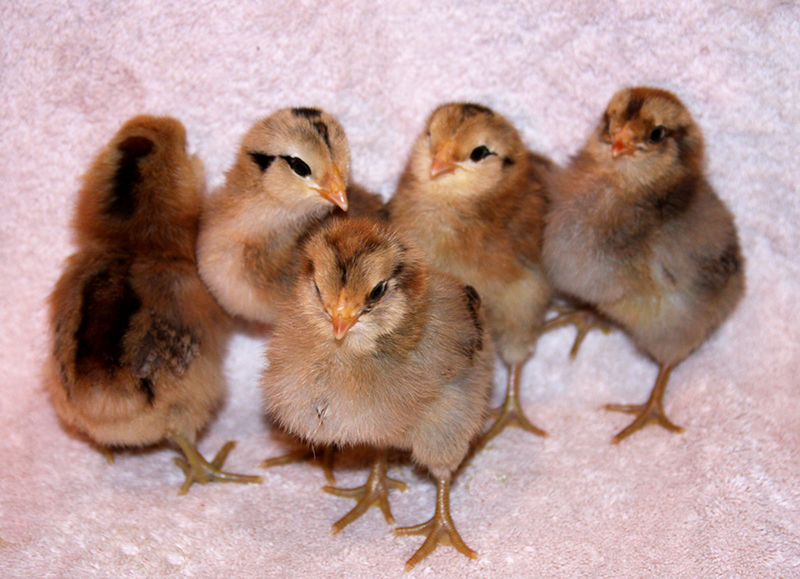
It happened again this week. I was at my local feed store, minding my own business as I strolled the aisles for oyster shell and chicken treats, when I heard it: cheep cheep cheep cheep cheep cheep!
Chick Days had officially begun in Michigan, despite the sub-freezing temperature and the blanket of snow outside. I followed the high-pitched peeping to the middle of the store, where heat lamps hovered over metal stock tanks, each containing dozens of baby chicks huddled together like massive downy carpets. I couldn’t resist peeking at the babies as I read each tank label: Red Sex Link. Barred Rock. Cornish Cross, Australorp. And then there it was: Americana.
I’m quite positive that the cashier at the front of the store heard my loud groan of frustration. These chicks were not Americanas. They weren’t even Ameraucanas. They were Easter Eggers.
If you want to add blue egg layers to your flock, Easter Eggers will do the job nicely. They are friendly, curious birds that lay well and winter well in chilly climates. If you plan to someday breed and sell your own chicks, however—or if you plan to exhibit show poultry—you must be able to distinguish between an Easter Egger and a true Ameraucana. Unsure of the distinctions? Read on to learn the three quick A’s to help you differentiate between these two farmyard favorites.
Ancestry
Unlike the Ameraucana, the Easter Egger is not an actual breed. It is a hybrid chicken, the result of crossing a blue-egg-laying breed with another breed, usually a brown-egg layer. Like the Ameraucana and its close cousin, the Araucana, the Easter Egger possesses the gene for blue eggs. While the Ameraucana and the Araucana always lay sky-blue eggs, however, the Easter Egger lays eggs in an array of pastels, including green, pink and yellow (hence the name “Easter Egger”) thanks to its mixed heritage. Note: One Easter Egger hen will not lay a rainbow of egg colors but rather one color throughout her laying years.
Appearance
Ameraucanas and Easter Eggers sport fluffy muffs and beards, both of which give these chickens their characteristic full-cheeked faces. Both birds have cold-hardy features such as pea combs and miniscule (or absent) wattles, small earlobes, and full hackles and tail feathers. Coloration, however, is where the two diverge. The American Poultry Association recognizes only eight varieties of Ameraucana: black, blue, wheaten, blue wheaten, white, silver, buff and brown red. The Easter Egger has limitless variations, with its mixed lineage coming through strongly in its feather coloration and patterning. Columbian Wyandotte parentage, for example, might yield an Easter Egger with dramatic white and black feathering, while a Buff Orpington pedigree might result in golden Easter Egger chicks. A Rhode Island Red bloodline might bring about a dark auburn bird.
The confusion between Easter Eggers and Ameraucanas can be further compounded when the mixed breed features purebred coloration. Not sure whether your chicken is a blue Easter Egger or a blue Ameraucana? Check its shanks. The Standard of Perfection defines the color shank for each recognized Ameraucana variety (for a blue Ameraucana, slate shanks and toes with white bottoms). An Easter Egger’s shanks are most commonly dark olive but can be any color, depending on its lineage.
Availability
A limited number of commercial hatcheries now offer purebred Ameraucana chicks, usually with a disclaimer that these babies are not meant for exhibition. The vast majority of purebred Ameraucanas are available only through private breeders. If you wish to raise your own flock of true Ameraucanas, consider consulting breeder directories such as those found online at the Ameraucana Breeders Club or the Ameraucana Alliance. Depending on the variety, expect to spend between $10 and $30—or more—per Ameraucana chick.
That price difference is the chief telltale sign that your feed store’s Ameraucanas are actually Easter Eggers. These hybrid baby chicks usually sell for $1 to $3 apiece and, unlike Ameraucanas, are practically ubiquitous. You’ll find Easter Egger chicks at feed shops, farm-supply stores, local farms and commercial hatcheries. Unfortunately, many of these places sell their Easter Egger chicks as Ameraucanas—or Americanas, Araucanas and even Acurananas. This mislabeling is typically not done out of malice but out of ignorance. As retail businesses, these shops and hatcheries focus on moving merchandise rather than discovering details regarding their product. The farmers selling “Ameraucana” chicks most likely originally purchased mislabeled chicks from hatcheries, farm-supply stores and feed shops.
Upon seeing the Americana sign on that stock tank, I fleetingly considered finding the shop owners and explaining the difference between Easter Eggers and Ameraucanas. I’ve tried every single spring for the past three years, though, once even providing a comparison chart. In the end, I decided that it’s more important for you to know the difference than it is for them.




